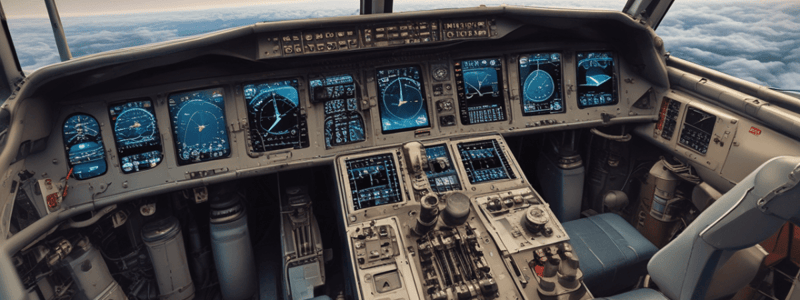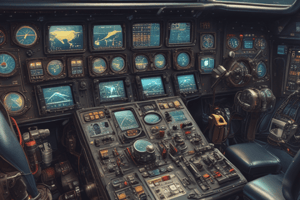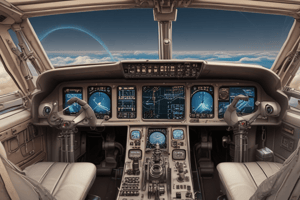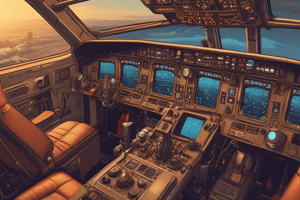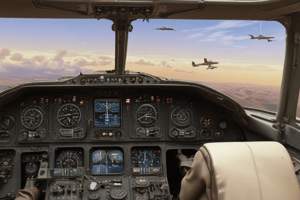Podcast
Questions and Answers
What is the primary purpose of flaps during flight?
What is the primary purpose of flaps during flight?
- To reduce drag during cruise
- To aid in roll control
- To increase lift at higher speeds
- To increase lift at lower speeds (correct)
What can occur if adverse yaw is not properly countered?
What can occur if adverse yaw is not properly countered?
- Improved aircraft performance
- Increased lift during takeoff
- Reduced aircraft safety (correct)
- Enhanced handling during stalls
What is a unique challenge posed by the T-tail configuration during stall recovery?
What is a unique challenge posed by the T-tail configuration during stall recovery?
- Delaying airflow separation
- Preventing flutter
- Requires special pilot training (correct)
- Improving handling during turns
What is the primary function of spoilers in aircraft?
What is the primary function of spoilers in aircraft?
What is the purpose of leading-edge devices in aircraft?
What is the purpose of leading-edge devices in aircraft?
What is the primary benefit of trim systems in aircraft?
What is the primary benefit of trim systems in aircraft?
What is the primary function of autopilot systems in aircraft?
What is the primary function of autopilot systems in aircraft?
What can be a consequence of failing to properly manage aircraft systems?
What can be a consequence of failing to properly manage aircraft systems?
What is the result of not properly countering adverse yaw?
What is the result of not properly countering adverse yaw?
What is a benefit of rigorous pilot training?
What is a benefit of rigorous pilot training?
Aircraft systems are completely independent of each other and do not affect one another.
Aircraft systems are completely independent of each other and do not affect one another.
T-tail configurations are only used in aircraft with high wingloads.
T-tail configurations are only used in aircraft with high wingloads.
Flaps only increase lift during cruise phases of flight.
Flaps only increase lift during cruise phases of flight.
Spoilers are used primarily for pitch control during flight.
Spoilers are used primarily for pitch control during flight.
Trim systems are only used in aircraft with autopilot systems.
Trim systems are only used in aircraft with autopilot systems.
Autopilot systems can only maintain level flight and cannot adapt to changing course directions.
Autopilot systems can only maintain level flight and cannot adapt to changing course directions.
Flutter can be completely eliminated by using a T-tail configuration.
Flutter can be completely eliminated by using a T-tail configuration.
Aircraft stability and control are solely dependent on the pilot's skills.
Aircraft stability and control are solely dependent on the pilot's skills.
Pilot error is the only cause of incidents in aircraft.
Pilot error is the only cause of incidents in aircraft.
The primary role of leading-edge devices is to reduce drag during cruise.
The primary role of leading-edge devices is to reduce drag during cruise.
How do coordinated turns minimize adverse yaw, and what would be the consequences if not properly countered?
How do coordinated turns minimize adverse yaw, and what would be the consequences if not properly countered?
What is the dual role of spoilers in aircraft, and how do they contribute to safe and efficient flight?
What is the dual role of spoilers in aircraft, and how do they contribute to safe and efficient flight?
What is the significance of the T-tail configuration in aircraft design, and how does it impact aerodynamic characteristics?
What is the significance of the T-tail configuration in aircraft design, and how does it impact aerodynamic characteristics?
How do secondary flight controls, including flaps and leading-edge devices, modify an aircraft's aerodynamic profile?
How do secondary flight controls, including flaps and leading-edge devices, modify an aircraft's aerodynamic profile?
What is the significance of trim systems in aircraft, and how do they alleviate pilot workload?
What is the significance of trim systems in aircraft, and how do they alleviate pilot workload?
How do autopilot systems aid pilots in maintaining level flight and adhering to set courses?
How do autopilot systems aid pilots in maintaining level flight and adhering to set courses?
What is the significance of the interconnectedness of aircraft systems, and how do incidents reveal the consequences of failing to manage these systems?
What is the significance of the interconnectedness of aircraft systems, and how do incidents reveal the consequences of failing to manage these systems?
How do leading-edge devices enhance lift and prevent stalls, and what is their significance in aircraft design?
How do leading-edge devices enhance lift and prevent stalls, and what is their significance in aircraft design?
What is the significance of rigorous pilot training in maintaining aircraft stability and control, and how does it impact flight safety?
What is the significance of rigorous pilot training in maintaining aircraft stability and control, and how does it impact flight safety?
What is the role of aircraft systems in maintaining stability and control, and how do they interact with each other?
What is the role of aircraft systems in maintaining stability and control, and how do they interact with each other?
Flashcards are hidden until you start studying
Study Notes
Primary Flight Controls
- Ailerons, elevators, and rudder are vital for maneuvering along the roll, pitch, and yaw axes, respectively.
- Ailerons play a pivotal role in controlling an aircraft's roll, and failure of one aileron during flight can compromise roll control.
- Elevators are responsible for the pitch of the aircraft and are crucial in adjusting the nose-up or nose-down attitude to prevent a stall or uncontrollable descent during incidents like sudden wind shear.
- The rudder guides the aircraft's nose left or right and is essential in maintaining directional control during engine failure on a multi-engine aircraft.
T-Tail Design
- The T-tail design offers improved control and reduced interference from wing wake.
- The design helps prevent flutter, a dangerous oscillation that can lead to structural failure.
- However, the T-tail can mask early stall warnings, leading to sudden and sharp stalls, requiring pilots to recognize and recover from stalls unique to T-tail designs.
Case Studies and Real-World Scenarios
- The "Gimli Glider" incident, where an airliner glided to a safe landing without engine power, demonstrates the importance of advanced control systems and pilot skills.
- Studying real-world scenarios and case studies helps pilots understand the symbiotic relationship between aircraft design, control systems, and pilot training, ensuring safety remains paramount.
Secondary and Auxiliary Flight Controls
- Secondary flight controls, such as flaps and leading edge devices, play a crucial role in adjusting an aircraft's lift and drag characteristics during takeoff and landing.
- Flaps enhance lift at lower speeds, allowing for smoother takeoffs and landings.
- Leading edge devices improve airflow over the wings, allowing for safer flight operations.
- Spoilers disrupt airflow, decreasing lift, and increasing drag, and are crucial for managing the energy of an aircraft upon landing.
- Correct usage of secondary flight controls provides substantially improved performance and safety.
Importance of Case Studies
- Case studies are not just stories but serve as strategic learning tools that bind theory with practice.
- They help pilots understand the direct influence of control systems on aviation standards, why they operate the way they do today, and ultimately save lives.
- Knowledge of these systems is not just procedural but foundational to the fabric of aviation safety.
Primary Flight Controls
- Ailerons, elevators, and rudders are vital for maneuvering along the roll, pitch, and yaw axes, respectively.
- Ailerons control an aircraft's roll, and their failure during flight compromises roll control.
- Elevators control pitch, and their input is crucial in adjusting the nose-up or nose-down attitude to prevent a stall or uncontrollable descent.
- Rudders control yaw, and their prowess helps maintain directional control, countering the asymmetrical thrust or drag in situations like an engine failure on a multi-engine aircraft.
Secondary Flight Controls
- Flaps, leading edge devices, and spoilers play a crucial role in adjusting an aircraft's lift and drag characteristics.
- Flaps enhance lift at lower speeds, facilitating takeoff and landing.
- Leading edge devices improve airflow over the wings, allowing for smoother and safer flight operations.
- Spoilers can be deployed upward to disrupt airflow, decreasing lift and increasing drag, and are crucial for managing the energy of an aircraft upon landing.
Case Studies and Aviation Safety
- Understanding the primary and secondary flight controls is critical for aviation safety.
- Case studies of aircraft incidents provide valuable insights into the general role of control systems in aircraft performance.
- These studies illustrate the importance of proper control system usage, highlighting the consequences of incorrect usage.
Aircraft Design and Control Systems
- The T-tail configuration presents unique aerodynamic characteristics, including the prevention of flutter and improvement of handling during stalls.
- However, it also poses specific challenges during stall recovery that pilots must be trained to address.
- Aircraft design and control systems interact, influencing safety during unexpected flight conditions.
Advanced Control Systems
- Mechanical control systems have been the mainstay of aviation for decades.
- Fly-by-wire systems offer numerous benefits, including weight reduction, ease of maintenance, and the ability to incorporate sophisticated flight envelope protections.
- However, they also introduce complexity and potential challenges that must be thoroughly understood and managed.
Importance of Training and Understanding
- Pilots must be trained to expertly manage primary and secondary flight controls to execute safe and efficient maneuvers.
- Understanding the interconnectedness of aircraft systems is critical for maintaining aircraft stability and control.
- Rigorous training and a deep appreciation for the sophisticated nature of modern aviation technology are essential for preventing incidents and ensuring safety.
Primary Flight Controls
- Ailerons, elevators, and rudder are vital for maneuvering along the roll, pitch, and yaw axes, respectively.
- Ailerons play a pivotal role in controlling an aircraft's roll, and failure of one aileron during flight can compromise roll control.
- Elevators are responsible for the pitch of the aircraft and are crucial in adjusting the nose-up or nose-down attitude to prevent a stall or uncontrollable descent during incidents like sudden wind shear.
- The rudder guides the aircraft's nose left or right and is essential in maintaining directional control during engine failure on a multi-engine aircraft.
T-Tail Design
- The T-tail design offers improved control and reduced interference from wing wake.
- The design helps prevent flutter, a dangerous oscillation that can lead to structural failure.
- However, the T-tail can mask early stall warnings, leading to sudden and sharp stalls, requiring pilots to recognize and recover from stalls unique to T-tail designs.
Case Studies and Real-World Scenarios
- The "Gimli Glider" incident, where an airliner glided to a safe landing without engine power, demonstrates the importance of advanced control systems and pilot skills.
- Studying real-world scenarios and case studies helps pilots understand the symbiotic relationship between aircraft design, control systems, and pilot training, ensuring safety remains paramount.
Secondary and Auxiliary Flight Controls
- Secondary flight controls, such as flaps and leading edge devices, play a crucial role in adjusting an aircraft's lift and drag characteristics during takeoff and landing.
- Flaps enhance lift at lower speeds, allowing for smoother takeoffs and landings.
- Leading edge devices improve airflow over the wings, allowing for safer flight operations.
- Spoilers disrupt airflow, decreasing lift, and increasing drag, and are crucial for managing the energy of an aircraft upon landing.
- Correct usage of secondary flight controls provides substantially improved performance and safety.
Importance of Case Studies
- Case studies are not just stories but serve as strategic learning tools that bind theory with practice.
- They help pilots understand the direct influence of control systems on aviation standards, why they operate the way they do today, and ultimately save lives.
- Knowledge of these systems is not just procedural but foundational to the fabric of aviation safety.
Studying That Suits You
Use AI to generate personalized quizzes and flashcards to suit your learning preferences.
